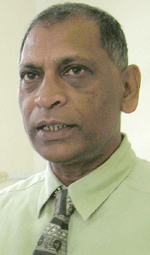Ramsammy advocates more collaboration among rice industry stakeholders
AGRICULTURE Minister Dr. Leslie Ramsammy has called for a collaborative effort amongst the Government, rice farmers and millers, to ensure that measures are put in place so that planters can start the planting exercise together.  In an exclusive interview with the Guyana Chronicle, he expressed the hope that, in time, there is greater synchrony on when rice farmers sow and reap their crops.
In an exclusive interview with the Guyana Chronicle, he expressed the hope that, in time, there is greater synchrony on when rice farmers sow and reap their crops.
According to him, one of the continuous problems being experienced is disharmony in the timeline for farmers. He added that when planters are supposed to be preparing to plant the next crop, some of them are still harvesting the first crop, because they started the first crop late and are caught in the middle of the rainy season.
The Minister said this situation has put an additional burden on the Ministry of Agriculture, as it has to help the farmers overcome the challenges of protecting their cultivations which are still on the ground.
One of the contributing challenging factors is the unfavourable weather pattern, he explained.
Ramsammy said, presently, just over 80 percent of the first crop has been harvested, with most of the farmers in Regions Two (Pomeroon/Supenaam) and Three (Essequibo Islands/West Demerara) having reaped their first crop and are preparing for their second. Indeed, many farmers in those Regions have not only prepared their fields but have already begun to sow for the second crop.
LATE HARVESTERS
He said the majority of the late harvesters caught by the rain are in Regions Four (Demerara/Mahaica) and Five (Mahaica/Berbice).
Additionally, delayed payment by millers is another reason for the planters’ lateness in sowing, since many of them are being paid late.
Ramsammy admitted, though, that when farmers are not sowing together, it is not because they intended to be uncooperative.
But he reiterated the necessity for more collaboration by all stakeholders involved in the production.
“They have to look at all the factors, as farmers depend on monies from their previous crops and millers are not paying them. Often times, they have to go to the bank to borrow money,” Ramsammy remarked.
However, he posited that approaching the banks is not the solution to the problem since most of the loans are not long term and the lending institutions expect to be fully repaid at the end of the crop.
Ramsammy said, at the end of a crop, it does not mean that farmers have money in their hands.
He said he does not want his call for harmony to be taken out of context and cited several factors that are contributory to the disharmony, resulting in blame not squarely on one party.
The Minister said the first 2012 crop was very challenging for the farmers and the Ministry of Agriculture, as the latter was called upon, many times, to assist the former.
It was challenging through factors that were out of control, including the procurement of fertilisers and a global increase in the price of seeds.
REMAINS AFFORDABLE
Ramsammy assured that the Ministry will continue to make sure that there is adequate supply of fertiliser and the price remains affordable.
He said one of the problems is that fertiliser has to be bought in quantities of no more that 6,000 tonnes at a time while the amount needed in Guyana is approximately 30,000 tonnes, not only for rice.
The Minister said that quantity cannot be brought in at one time and that is a constraint that Guyana will have to face until it gets a deep water harbour.
“This has been a particularly weathered first crop as November/ December, which is the land preparatory period, was significantly affected by poor weather conditions and January/February, when the farmers were supposed to be in the middle of their crop, poor weather also prevailed in all of the rice growing regions,” he asserted.
Ramsammy said the first crop started out with a target of 78,000 hectares and one of the success stories of the industry is its resilience of the rice farmers. Given the continuous weather impact, they were still able, after 80 percent of the harvest, to record the equivalent of 196,000 tonnes.
He said the first crop production was forecast for 200,000 tonnes but, at the end of the harvest, it will surpass that, despite the continuous challenge from the weather throughout the land preparation, sowing, growing and reaping.
Ramsammy is of the opinion that the total rice production for the year will overtake that of previous years.




.jpg)










